
We play real pool, with real pool tables, real players from everywhere. We are an international pool tournament that connects players through new, state of the art technology. We offer the most accurate handicapping system that verifies players and offers match verification. We are the industry leader and will stay that way. We use a digital skorbord that date and time stamps player’s matches for real time streaming verification of matches. This is a members only tournament. Click here to REGISTER AS A MEMBER to participate.
To participate in any tournament you must be a Ghost Billiards member. If you haven’t registered yet click here.
You will need two devices to play the tournaments. One to stream and one to score. You can use any two devices: tablet, laptop with a camera, iPad, cell phone etc. that is connected to the internet.
You choose your devices.
General Rules – Apply To All Games
View Download PDF220 (10 ball)
View Download PDF198 (9 ball)
View Download PDF176 (8 ball)
View Download PDF110 (Straight Pool)
View Download PDF198 & 154 Banks
View Download PDFSnooker
We're Working On It. Stay Tuned.
View Download PDFHonolulu
We're Working On It. Stay Tuned.
View Download PDFEnglish 176 (English 8 ball)
We're Working On It. Stay Tuned.
View Download PDFChinese 176 (Chinese 8 ball)
We're Working On It. Stay Tuned.
View Download PDFReporting Your Matches
Ghost –
is an imaginary opponent where you play against the 'ghost'. You win if run-out (following the game rules required for each game). Playing the 'Ghost' offers a framework for tracking player's improvement and statistics for each game.
Table Identification
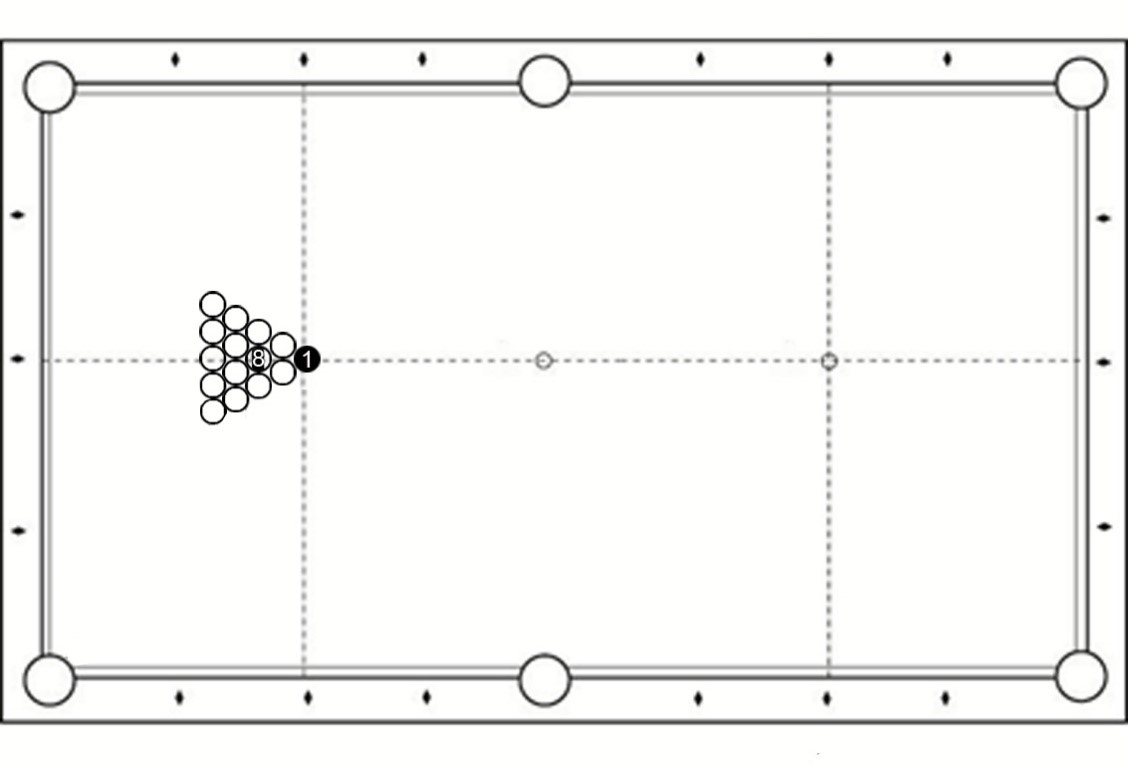
Be sure to read the game rules for each specific game you will be playing. If you don't know the rules and you mark the scoreboard incorrectly, the match is void, no refunds and could be a termination of membership. Take advantage of the videos provided on the website to help you with reporting your match. We have a One and Done Policy here at Ghost Billiards. If you manipulate you score, loose the opportunity to play. Forever. You have been given fair warning.
The game consists of two turns at the table.
Turn One (1): The break
Turn Two (2): Run balls until a shot is missed of a foul is committed
Most but not all games are played this way. Read the specific videos for the game you will be playing.
Rack: Must be a legal rack according to each game rules. (See the game index below). When using a standard break rack, all balls must be pressed tightly inside the triangle with all balls frozen to each other. We allow and encourage the use of the film racks (See the website for the Tite-n-Rite film racks) for most consistent racking.
Break
To execute a legal break shot the shooter will start with ball in hand behind the headstring with the base of the cue ball behind the headstring striking the required ball if any in accordance to each game rules (See the game index).
Initiating a Shot: All shots must be initiated by contacting the tip of the cue stick when striking cue ball.
Interfering the Break: On the break stopping or changing the path of the cue ball after it passes the headstring is a foul and concludes the first shot at the table.
1st turn at the table is the break shot.
2nd turn at the table: Played by the game rules, the shooter will take "Ball in hand" after the break. The shooting player is allowed, to pick up the cue ball and place it anywhere on the table to start his/her run of pocketing balls. To win the game a player must legally pocket all the balls according to game rules during this turn at the table. A miss or foul or Runout on this shot concludes this turn at the table.
Conclusion of 2nd turn: If no ball is pocketed or a foul is committed, the player's 2nd turn is over and game is concluded.
When a foul is committed on the break shot it is a deduction of one (1) point in most games off your total game score with the exception of 110 and Banks games. A foul on the break in 110 and Bank games is a deduction of two (2) points off your total game score. The following are fouls for all games:
There is no point deduction for fouls on your second turn at the table. A foul on your second turn at the table is loss of turn and game over. If a ball is pocketed and a foul is committed during the shot, the scoreboard will deduct the point from you total game balls. Fouls for play are as follows:
If a ball is pocketed and there is a foul committed on the break of any game, there is a penalty given and the ball pocketed is spotted on the foot spot and play continues according to game rules.
(rules for semi-pro, advanced, open and intermediate divisions)
The object of 220 is to break the balls and run out each rack for 11 games according to the game rules as follows:
All general rules apply to the game of 220. Be sure to read the general rules prior to playing your match.
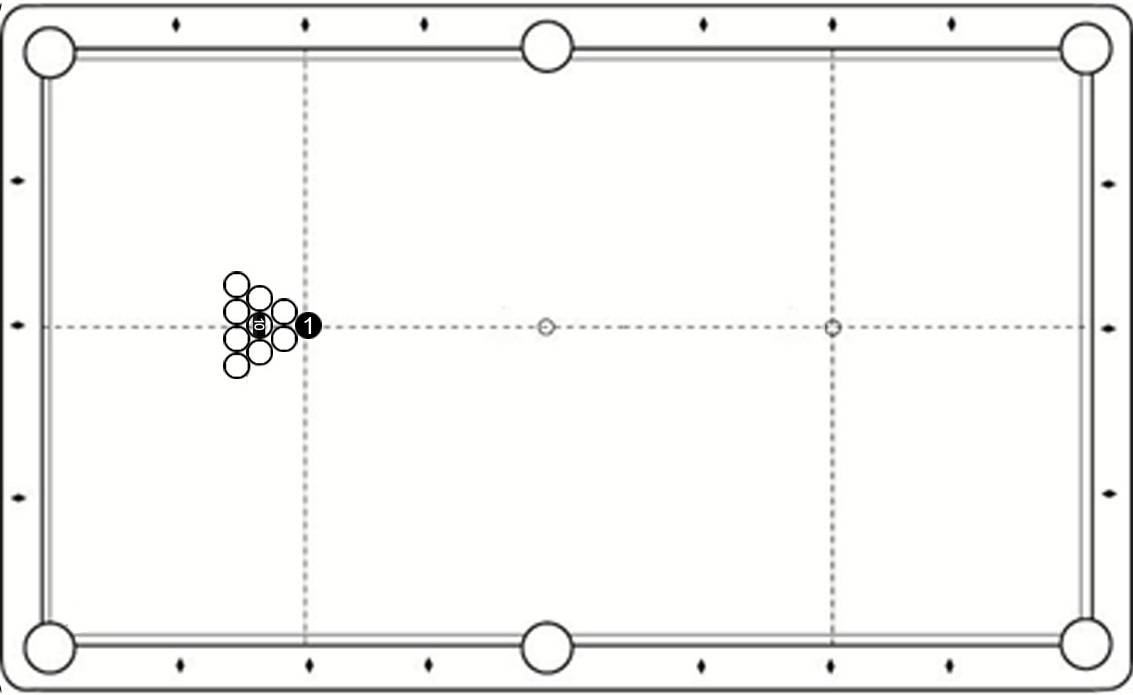
Scoring a perfect match of 220 occurs after a legal break shot has been executed, pocketing at least one ball on the break or successfully executing the Cut Option (COE) and legally run-out without missing any of the balls on the table. You must successfully execute this in each game until you have played 12 games. To execute perfect games throughout your match (12 games) it is, considered to be a perfect match of 220 points. It is possible to score more than 220 points but scoring 220 points in the manner just described is viewed as a perfect game.
(rules for semi-pro, advanced, open and intermediate divisions)
The object of 198 is to break the balls and run out each rack for 11 games (or the predetermined number of games) according to the game rules as follows:
All general rules apply to the game of 220. Be sure to read the general rules prior to playing your match.
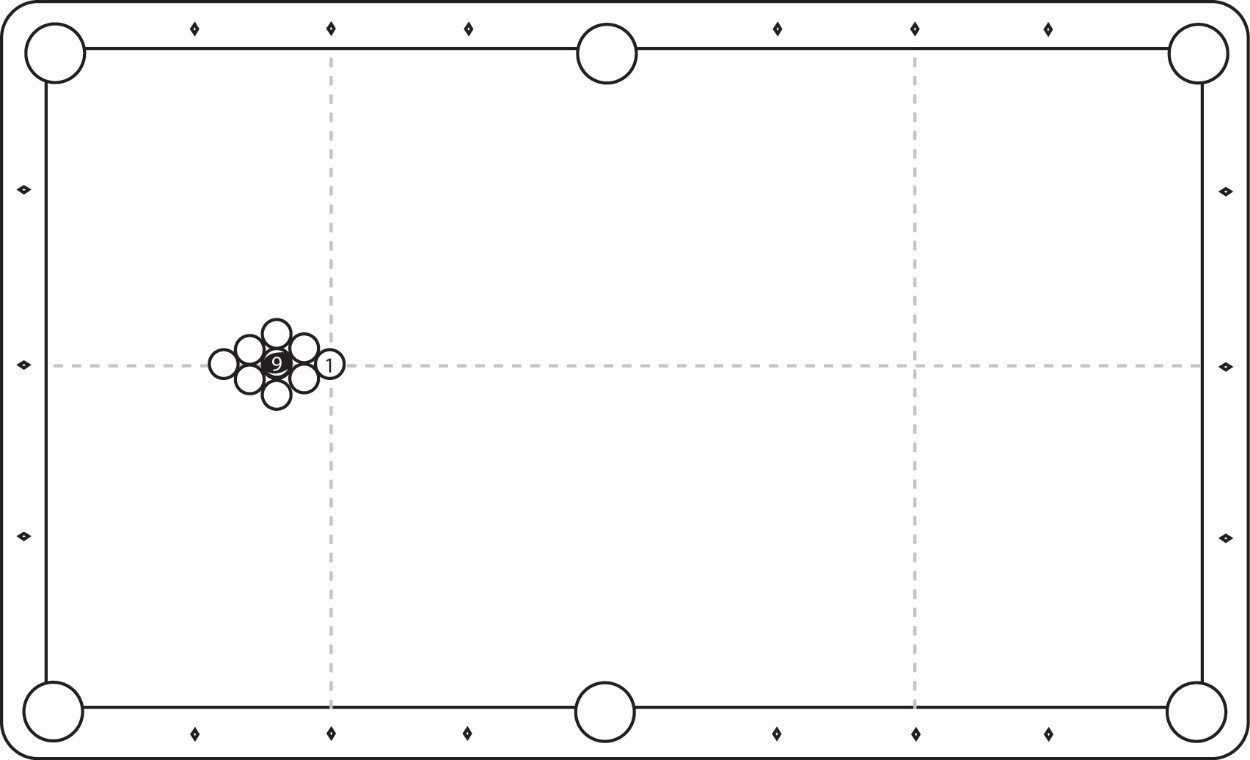
Scoring a perfect match of 198 occurs after a legal break shot has been executed, pocketing at least one ball on the break or successfully executing the Cut Option (COE) and legally run-out without missing any of the balls on the table. You must successfully execute this in each game until you have played 12 games. To execute perfect games throughout your match (12 games) it is, considered to be a perfect match of 198 points. It is possible to score more than 198 points but scoring 198 points in the manner just described is viewed as a perfect game.
(rules for semi-pro, advanced, open and intermediate divisions)
The object of 176 is to break the balls, select solids or stripes (red or yellow) and legally pocket the selected suite plus the 8 ball (black ball) for 12 games according to the game rules as follows:
All general rules apply to the game of 176. Be sure to read the general rules prior to playing your match.
Note for ALL Games: The shooter must legally sink a ball on all shots until all the balls on the table are pocketed successfully. If the player is able to successfully run-out, it is a game won. If the player performs an illegal shot (i.e. contacting a ball from the non-designated category first, jumping an object ball off the table etc.), or fail to sink a ball on a shot then this would conclude that game and is a loss of game and the earned points are scored.

CUT Game
SNAP
A SNAP game is when a player pockets at least one ball on the break and legally pockets all the balls of the declared suit plus the 8 ball off the table.
If the player is successful in the 11th game of running out without missing, the player is entitled to one last game, a 12th game to finish scoring the 11th game. This last game is played by the same rules as the rest of the match.
Scoring a perfect match of 176 occurs after a legal break shot has been executed, pocketing at least one ball on the break or successfully executing the Cut Option (COE) and legally run-out without missing any of the balls on the table. You must successfully execute this in each game until you have played 12 games. To execute perfect games throughout your match (12 games) it is, considered to be a perfect match of 176 points. It is possible to score more than 176 points because of the balls pocketed on the break but scoring 176 points in the manner just described is viewed as a perfect 176 match.
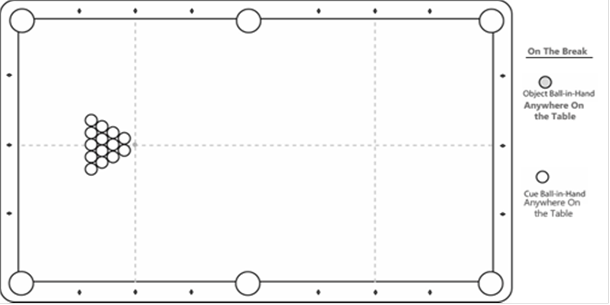
If the shooter commits a standard foul, a point is subtracted from his score and a new game is started with a new rack.
(rules for semi-pro, advanced, open and intermediate divisions)
The objective to playing Breaking balls is to pocket as many balls as possible on the break and legally pocket all 9 balls by using one or more rails.
All general rules apply to the game of Breaking Banks. Be sure to read the general rules prior to playing your match with the exception of ball-in-hand after the break.
198 Banks Rules – (Modified 9 ball Banks)
198 Banks is a call shot game. Player must designate a pocket and ball for every shot.
A player must first declare the ball they are shooting and then designate the pocket by using their stick and pointing to the ball first and then the pocket.
If the player is using more than one rail for their next shot, the player must first declare the ball they are intending to pocket and then show the number of rails they will be using by holding up the corresponding number of fingers and then point to the rails they will be using.
Player earns one point for every rail used when pocketing a ball.
Player may shoot the balls in any order.
Player may take one (1) ball-in-hand turn at any time during a game.
Bank combinations are allowed.
One rail kick shots are not allowed.
Two or more rail kick shots are allowed.
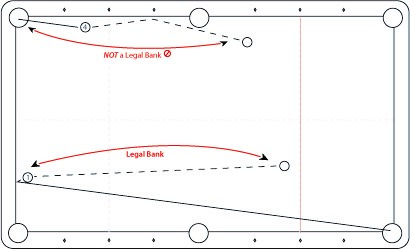
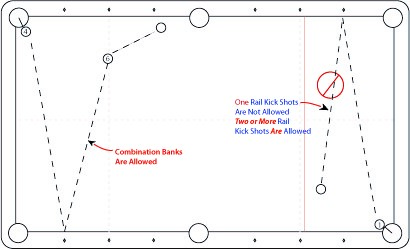
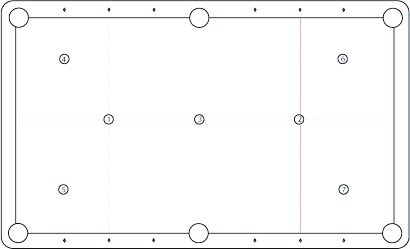
Don't Fret! The scoreboard is user friendly and will take care of the scoring once you input the information. This section is for your information and explains how to record the results of your match.
Scoring a perfect match of 198 Banks occurs after a legal break shot has been executed, pocketing at least one ball on the break or successfully executing the Cut Option (COE) and legally run-out without missing any of the balls on the table for 12 consecutive racks. To execute perfect games throughout your match (12 games) it is, considered to be a perfect match of 198 points. It is possible to score more than 198 points but scoring 198 points in the manner just described is viewed as a perfect game.
Scoring a perfect match of 154 Banks occurs after a legal break shot has been executed, pocketing at least one ball on the break or successfully executing the Cut Option (COE) and legally run-out without missing any of the balls on the table for 12 consecutive racks. To execute perfect games throughout your match (12 games) it is, considered to be a perfect match of 154 points. It is possible to score more than 154 points but scoring 154 points in the manner just described is viewed as a perfect game.
This is Scoring section.
Games:
Games Coming Soon
We offer the largest variety of formats.
We keep 14 different stats on every match. Match statistics are stored in the Player’s Statistics page so players
can track their progress and analyze their matches.
Even though we calculate match scores to /100th of a point, there may be a scoring tie. The match statistics are
used for tie-breakers. If there was a tie score in any tournament the match statistics are compared and a winner is identified.
All events have a start date and time and a finish date and time.
On the tournament registration page it will display which events are currently running. We run many different types of events and always run a weekly event.
We offer the most accurate handicapping system in the industry.
Handicaps are based on your latest 20 matches, put into a formula and the result is a handicap that is calculated out to 1/100 of a point.
Most of the tournaments are handicapped, but from time to time we will run scratch events. If you do not wish to participate in the handicap events you can always play in the professional division where handicaps are not used.
Challenge matches can be set to be played handicapped or scratch.
To receive a handicap, players must play 6 matches in the scratch division. Yes, these divisions pay money. Players compete against other players with a similar skill set and no handicap for the first six matches. 5 Divisions and all divisions pay based on the number of players just like the handicapped events.
Once you play your first match the GB system will evaluate your match and based on those results will assign you to a division. Your division may change from week to week in the beginning until your skill level is determined.
Players are allowed, to challenge up in a division but are not allowed to play down in divisions. The division(s) you are qualified to play will display during tournament registration.
Support our team captains and they will support you.
During registration you will have the option to select one of our ambassadors of our sport to be your team captain.
The team captains will put up challenges from time to time and you will be able to compete from top notch prizes, maybe even a one-on-one video lesson with your captain.
Players will also have the opportunity to participate in the Pro-Am events. The events might be a team selected by your captain or it might be a team vs team event.
Check out the Team Captains.
If you’ve been reading the information on this website, by now you will know the many benefits of joining and supporting Ghost Billiards. But, what’s in it for you?
Ghost Billiards is a grooming ladder, a learning tool, a place to compete and challenge yourself and the chance to win money. But, what you may not know is that you can earn commissions just by playing and introducing your friends.
GB cares about the players, so we believe in rewarding the players that help us grow. Without you there would be no tournaments.
If you refer a friend, give them your member ID # and ask them to put it in the “Referring Member ID” when they register. Why?
Because when your friend joins GB you will earn $0.50 every time your friend plays a match. Forever! Doesn’t sound like much, but over time if you have a few friends playing you might get to swing at the cash for free once in a while.
If you’re building a team for the 3, 4 or 5 player team events, be sure to give them your member ID prior to them registering so you can earn more money. Why? Because you’ve earned it.
It’s our way of saying thank you for playing and supporting Ghost Billiards.
You are already a registered member. If you would like to register another player logout and try again.
© 2011-2020 | Behind the Rock Tour, LLC | All rights Reserved